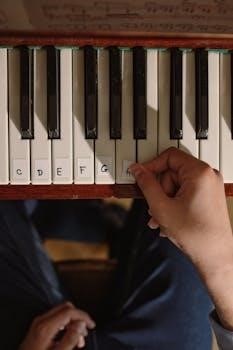
Scales and arpeggios are fundamental to piano playing, providing a foundation for technique and musicality. They help build finger strength, dexterity, and understanding of music theory. Regular practice enhances overall playing ability;
Importance of Scales and Arpeggios
Mastering scales and arpeggios is crucial for developing piano proficiency. These exercises provide a framework for understanding musical structure, improving finger dexterity, and enhancing hand coordination. Regular practice of scales and arpeggios builds a strong technical foundation that supports more advanced musical pieces. They help in developing a sense of touch, evenness, and speed, which are vital for expressive playing. Furthermore, these exercises familiarize pianists with key signatures and the relationships between notes, contributing to a deeper musical understanding. Scales and arpeggios are not just technical drills; they are the building blocks of musical language, enabling more fluent and confident performance. Consistent practice improves accuracy and speed, laying the foundation for mastering complex musical pieces and fostering overall musicianship. They are essential for developing both technical skills and musical awareness.

Types of Scales for Piano
Piano scales come in various forms, including major, minor (natural, harmonic, melodic), and chromatic. Each scale type has a unique pattern of whole and half steps, shaping its characteristic sound.
Major Scales
Major scales are the most fundamental scales in music, characterized by their bright and cheerful sound. They follow a specific pattern of whole (W) and half (H) steps⁚ W-W-H-W-W-W-H. This pattern is consistent across all major scales, regardless of the starting note. For example, the C major scale consists of the notes C-D-E-F-G-A-B-C, with no sharps or flats. The pattern is created by specific intervals between the notes. Mastering major scales is essential for building a strong technical foundation on the piano. They are a cornerstone for understanding harmony and melody, and they are used in countless musical pieces. Practicing major scales regularly will improve finger dexterity, evenness, and overall musicality. It is crucial to learn the correct fingerings for each major scale to ensure smooth and efficient playing. The major scales form the basis for many musical concepts and techniques.
Minor Scales (Natural, Harmonic, Melodic)
Minor scales provide a contrasting mood to major scales, often described as sad or melancholic. There are three main types of minor scales⁚ natural, harmonic, and melodic. The natural minor scale is created by altering the intervals of the major scale. The harmonic minor scale raises the 7th degree of the natural minor scale, which creates a unique and characteristic sound. The melodic minor scale differs in its ascending and descending forms, raising both the 6th and 7th degrees when ascending and reverting to the natural minor scale when descending. Each of these variations offers different melodic and harmonic possibilities, making them essential for a well-rounded understanding of music theory. Practicing all three types of minor scales is crucial for developing a comprehensive skill set and understanding the nuances of different musical styles. Mastering these scales enhances the player’s overall musical vocabulary.
Chromatic Scales
Chromatic scales are distinct from major and minor scales, encompassing all twelve notes within an octave. They proceed by half-steps, creating a smooth, flowing sound. Practicing chromatic scales is vital for developing evenness and agility across the entire keyboard. Unlike major and minor scales, chromatic scales do not adhere to a specific key, which means they can be played starting on any note. This makes them an excellent exercise for improving finger independence and coordination. The consistent interval of half-steps in chromatic scales helps in building a strong foundation for playing complex passages. Mastering the chromatic scale allows pianists to navigate any musical piece with greater ease and confidence. Furthermore, this scale enhances the player’s ability to execute rapid transitions between different keys and intervals, leading to improved overall technical proficiency. Regular practice can also greatly improve a pianist’s sense of intonation.

Understanding Piano Arpeggios
Arpeggios are broken chords, playing notes individually rather than simultaneously. They add fluidity and movement to music. Mastering them improves technique and understanding of harmony. Arpeggios are essential for piano playing.
Arpeggios Based on Major Triads
Arpeggios derived from major triads are foundational in piano technique, consisting of the root, major third, and perfect fifth of a major scale. These arpeggios are played by ascending and descending through these three notes, one at a time. They share a close relationship with major scales, often practiced alongside them to reinforce harmonic understanding. The pattern is consistent across all major keys, making it easier to internalize once the basic structure is learned. Practicing arpeggios based on major triads not only improves finger dexterity and coordination but also provides a melodic element to technical exercises. These exercises are important for developing musicality and are often used in a wide range of piano compositions. These arpeggios are important and should be part of your regular practice routine to enhance your overall piano skills. They are the building blocks for more advanced arpeggios and chord progressions.
Arpeggios Based on Minor Triads
Arpeggios built upon minor triads consist of the root, minor third, and perfect fifth of a minor scale. Unlike major arpeggios, these have a slightly different feel due to the minor third interval, which lends them a darker, more melancholic sound. Practicing these arpeggios is crucial for developing a complete understanding of harmony and for expanding expressive capabilities on the piano. The fingering patterns are similar to those of major arpeggios, but the sound is distinct, making them essential for any pianist’s technical arsenal. These arpeggios are often used in pieces to convey sadness or drama, and mastering them unlocks new possibilities for musical interpretation. Regular practice will not only enhance your finger dexterity but also help you become more attuned to the subtle differences between major and minor tonalities. These arpeggios are just as vital as major arpeggios and should be included in your regular practice.

Effective Practice Techniques
Effective practice involves using proper fingering, a metronome for consistent tempo, and focusing on evenness and accuracy. Start slowly and gradually increase speed while maintaining control and precision.
Fingering for Scales and Arpeggios
Correct fingering is crucial for smooth and efficient playing of scales and arpeggios. For scales, different keys require specific finger patterns to navigate the keyboard comfortably and fluidly. Generally, the thumb is used on the tonic note and the fourth finger is avoided on strong beats. In arpeggios, the thumb typically begins each set in the right hand, often following a 1-2-3 or 1-2-3-1 pattern. Consistency in fingering allows for the development of muscle memory, enabling faster and more accurate playing. It’s important to refer to reliable sources that provide fingering patterns for each scale and arpeggio. Mastering these patterns through diligent practice will significantly improve technical proficiency and overall piano playing skills. Remember, correct fingering is not just about speed; it’s about control, evenness, and musical expression. Using the correct fingering will make the playing of scales and arpeggios more accurate, fluid, and enjoyable.
Using a Metronome
Practicing scales and arpeggios with a metronome is essential for developing a strong sense of rhythm and timing. The metronome helps to maintain a consistent tempo, preventing rushing or dragging. Start at a slow tempo where you can play accurately and evenly, gradually increasing the speed as your proficiency improves. The goal is to achieve evenness and consistency rather than focusing solely on speed. Using a metronome also helps to identify areas where your playing may be uneven or inconsistent, allowing you to focus on specific challenges. It’s important not to increase the speed until you can play the passage perfectly at the current tempo. This systematic approach to practice, using the metronome as a guide, builds a strong foundation for rhythmic accuracy and control, crucial elements of excellent piano playing. Remember, consistent and even practice with a metronome is the key to mastering scales and arpeggios.

Resources for Learning
Many resources are available for learning scales and arpeggios. These include books, sheet music, and online tutorials. These resources can help with technique, theory, and practice methods.
Books and Sheet Music for Beginners
For beginners, selecting the right books and sheet music is crucial for building a strong foundation in piano scales and arpeggios. Look for resources that present major and minor scales in a clear, easy-to-understand format. Books often include fingering suggestions, which are essential for proper technique. Some beginner books also introduce arpeggios based on major and minor triads, which are fundamental building blocks. Consider resources that offer simplified sheet music for these exercises, focusing on one octave to start. This approach helps beginners focus on technique and evenness before increasing complexity. Books like “The Complete Book of Scales, Chords, Arpeggios & Cadences” and “Scales, Chords and Arpeggios for Piano⁚ The Brown Scale Book” are popular choices, but ensure they are beginner-friendly editions. Seek out materials that include clear diagrams of the keyboard, highlighting the notes in the scales and arpeggios. This visual aid makes learning easier and more engaging. It’s also helpful to find books that introduce a little music theory alongside the practical exercises.
Online Video Tutorials
Online video tutorials offer a dynamic way for beginners to learn piano scales and arpeggios. These tutorials often provide visual demonstrations of correct hand positions, fingerings, and posture, making it easier to grasp proper technique. Many instructors break down complex exercises into smaller, manageable steps, catering to different learning paces. Look for videos that focus on both major and minor scales, as well as arpeggios based on major and minor triads. Some tutorials include slow-motion segments, allowing beginners to clearly see how each finger moves. Additionally, online tutorials often show how scales and arpeggios fit into actual pieces of music, which helps motivate beginners. Consider channels and platforms that offer beginner-friendly content, such as those by experienced piano teachers or music educators. Some video series also provide printable PDF sheet music that complements the tutorial, enhancing the learning experience. Many video resources also demonstrate how to use a metronome effectively, which is crucial for evenness and rhythm in practice. Remember to check for tutorials that cover basic music theory, as this will enhance your understanding.